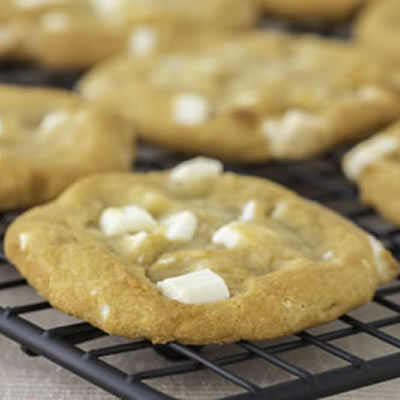White Chocolate
Also known as Compound Chocolate or Chocolate Coating
What is White Chocolate?
White chocolate is the solid or viscous material obtained by mixing and grinding cacao fat with dairy ingredients and nutritive carbohydrate sweeteners.1 White chocolate comprises cocoa butter, sugar, milk solids, and salt.
Origin
White chocolate is made from the butter of cacao beans. After the beans are harvested, they are processed further into cocoa butter (the fat component), chocolate liquor (the liquid component that contains not less than 50% nor more than 60% by weight of cocoa fat), and cocoa solids (the nonfat part of the cacao bean).1 White chocolate is based on the cocoa butter portion, mixed with other ingredients.
Nestlé first made white chocolate in 1930. In 1948 in the United States, they debuted the Alpine bar, a white chocolate bar with almonds. This was the first white chocolate product available in the U.S. and remained popular for many years. In 1993, Hershey’s developed “Hugs,” a white chocolate kiss. These became extremely popular, and made white chocolate a sought-after treat in the United States.
Nutrition
White chocolate should be eaten sparingly as part of a healthy diet. It has few nutrients, and is also low in antioxidants, unlike dark chocolate. The majority of the calories in white chocolate come from sugar and fat, and this product typically contains high levels of saturated fat as well.
Composition
According to the FDA, white chocolate contains not less than 20% cacao fat, not less than 3.5% milk fat, not less than 14% total milk solids, and not more than 55% nutritive carbohydrate sweetener.2
Besides cacao fat, these other ingredients may be found in it:2
- Nutritive carbohydrate sweeteners
- Dairy ingredients
- Emulsifying agents, used singly or in combination, the total of which does not exceed 1.5% by weight
- Spices, natural and artificial flavorings, ground whole nut meats, ground coffee, dried malted cereal extract, salt, and other seasonings that do not, either singly or in combination, impart a flavor that imitates the flavor of chocolate, milk, or butter
- Antioxidants
- Whey or whey products, the total of which does not exceed 5% by weight
Application
White chocolate is often used as a decoration because it creates contrast with darker chocolates. It is also used as an addition in many cookies and other baked goods such as biscotti, scones, and more. As with other chocolates, white chocolate in cookies and cakes adds texture as well, due to its fat content.1
White chocolate is temperamental and burns easily, so chefs must take care when working with this product. The shelf life of white chocolate is typically 6–10 months if kept in a cool, dry place.
The development of brown colors is one of the main problems that limit the shelf life of confectionery products manufactured with white chocolate or their substitutes. The brown tone is not from fat oxidation, but a result of non-enzymatic browning reactions. Controlling storage conditions and the permeability of packaging against water and gas vapors can delay browning.3
FDA regulation
The FDA regulates white chocolate in article 21CFR163.124:2
- FDA regulates the composition of white chocolate, as described in the “Composition” section.
- White chocolate shall be free of coloring material.
- If spices, flavors, or seasonings are used in white chocolate, this should be stated on the label.
References
- Bakerpedia. “Chocolate | Baking Ingredients.” bakerpedia.com/ingredients/chocolate/. Accessed 29 August 2017.
- US Food and Drug Administration. “21CFR163.124 – Code of Federal Regulations Title 21.” Accessdata.fda.gov, 1 April 2017, www.accessdata.fda.gov/scripts/cdrh/cfdocs/cfcfr/CFRSearch.cfm?fr=163.124. Accessed 28 August 2017.
- Vercet, A. “Browning of white chocolate during storage.” Food Chemistry, vol. 81, no. 3, 2003, pp. 371–377, doi:10.1016/s0308-8146(02)00452-1.


